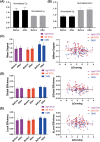Altered executive control network and default model network topology are linked to acute electronic cigarette use: A resting-state fNIRS study
- PMID: 38949205
- PMCID: PMC11215790
- DOI: 10.1111/adb.13423
Altered executive control network and default model network topology are linked to acute electronic cigarette use: A resting-state fNIRS study
Abstract
In recent years, electronic cigarettes (e-cigs) have gained popularity as stylish, safe, and effective smoking cessation aids, leading to widespread consumer acceptance. Although previous research has explored the acute effects of combustible cigarettes or nicotine replacement therapy on brain functional activities, studies on e-cigs have been limited. Using fNIRS, we conducted graph theory analysis on the resting-state functional connectivity of 61 male abstinent smokers both before and after vaping e-cigs. And we performed Pearson correlation analysis to investigate the relationship between alterations in network metrics and changes in craving. E-cig use resulted in increased degree centrality, nodal efficiency, and local efficiency within the executive control network (ECN), while causing a decrease in these properties within the default model network (DMN). These alterations were found to be correlated with reductions in craving, indicating a relationship between differing network topologies in the ECN and DMN and decreased craving. These findings suggest that the impact of e-cig usage on network topologies observed in male smokers resembles the effects observed with traditional cigarettes and other forms of nicotine delivery, providing valuable insights into their addictive potential and effectiveness as aids for smoking cessation.
Keywords: craving; default mode network; electronic cigarettes; executive control network; graph theory analysis.
© 2024 The Author(s). Addiction Biology published by John Wiley & Sons Ltd on behalf of Society for the Study of Addiction.
Conflict of interest statement
The authors declare that they have no known competing financial interests.
Figures


References
MeSH terms
Grants and funding
LinkOut - more resources
Full Text Sources
Medical

